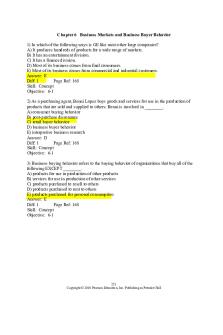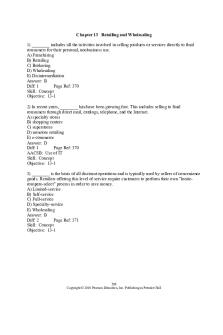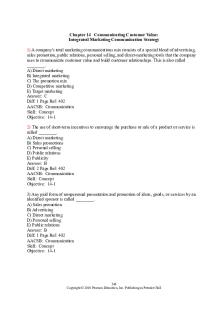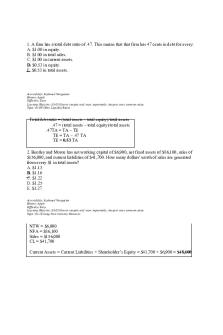Kotler Chapter 4 MCQ - Multiple choice questions with answers PDF

| Title | Kotler Chapter 4 MCQ - Multiple choice questions with answers |
|---|---|
| Course | Principles of Marketing |
| Institution | The University of the West Indies Mona |
| Pages | 44 |
| File Size | 474.6 KB |
| File Type | |
| Total Downloads | 121 |
| Total Views | 189 |
Summary
Multiple choice questions with answers...
Description
Chapter 4 Managing Marketing Information to Gain Customer Insights 1) Despite the data glut that marketing managers receive, they frequently complain that they lack ________. A) enough information of the right kind B) timely information C) accurate information D) reliable information E) valid information Answer: A Diff: 2 Page Ref: 100 AACSB: Communication Skill: Concept Objective: 4-1 2) Which of the following statements is NOT true regarding information collected for marketers? A) Many managers lack information of the right kind. B) Most managers do not need more information. C) Most managers need better information. D) Many managers are burdened by data overload. E) Managers have enough of the right information. Answer: E Diff: 3 Page Ref: 100 AACSB: Communication Skill: Concept Objective: 4-1 3) A marketing information system (MIS) consists of people and procedures to assess information needs, ________, and help decision makers analyze and use the information. A) experiment to develop information B) test market the information C) develop the needed information D) critique the needed information E) question the needed information Answer: C Diff: 1 Page Ref: 101 AACSB: Communication Skill: Concept Objective: 4-1
133 Copyright © 2010 Pearson Education, Inc. Publishing as Prentice Hall
4) A good MIS balances the information users would ________ against what they really ________ and what is ________. A) need; like; feasible B) like; can afford; needed C) like to have; need; feasible to offer D) need; can afford; useful E) use; have to use; available Answer: C Diff: 3 Page Ref: 102 Skill: Concept Objective: 4-2 5) Marketers must weigh carefully the costs of additional information against the ________ resulting from it. A) organization B) benefits C) creativity D) ethical issues E) cost Answer: B Diff: 1 Page Ref: 102 Skill: Concept Objective: 4-2 6) Four common sources of internal data include the accounting department, operations, the sales force, and the ________. A) owners B) stockholders C) marketing department D) competition E) Web Answer: C Diff: 2 Page Ref: 103 AACSB: Communication Skill: Concept Objective: 4-2
134 Copyright © 2010 Pearson Education, Inc. Publishing as Prentice Hall
7) Marketing information from which type of database usually can be accessed more quickly and cheaply than other information sources? A) external B) LexisNexis C) Dun & Bradstreet's D) internal E) Hoover's Answer: D Diff: 1 Page Ref: 103 AACSB: Use of IT Skill: Concept Objective: 4-2 8) ________ is the systematic collection and analysis of publicly available information about consumers, competitors, and developments in the marketing environment. A) Marketing data B) Marketing intelligence C) Sales management D) Customer intelligence E) Competitive intelligence Answer: B Diff: 1 Page Ref: 103 Skill: Concept Objective: 4-2 9) Which of the following statements regarding marketing intelligence is true? A) The advantage of using competitive intelligence is negligible. B) All marketing intelligence is available for free. C) Marketing intelligence relies upon privately held information. D) Marketing intelligence relies upon publicly available information. E) Marketing intelligence gathering is more focused on gaining insights into consumer activities than competitors' activities. Answer: D Diff: 2 Page Ref: 103 Skill: Concept Objective: 4-2 10) Which of the following is NOT considered a source of marketing intelligence? A) suppliers B) resellers C) key customers D) causal research E) activities of competitors Answer: D Diff: 2 Page Ref: 104 Skill: Concept Objective: 4-2 135 Copyright © 2010 Pearson Education, Inc. Publishing as Prentice Hall
11) Which of the following is NOT a potential source for marketing intelligence? A) looking through competitors' garbage B) purchasing competitors' products C) monitoring competitors' sales D) collecting primary data E) talking with purchasing agents Answer: D Diff: 2 Page Ref: 104 Skill: Concept Objective: 4-2 12) Through which of these sources of information is a competitor LEAST likely to reveal intelligence information? A) annual reports B) trade show exhibits C) Web pages D) press releases E) internal marketing conferences Answer: E Diff: 1 Page Ref: 104-105 AACSB: Communication Skill: Concept Objective: 4-2 13) To combat marketing intelligence efforts by competitors, Unilever Corporation is now providing ________ to employees. A) competitive intelligence training B) privacy blocks C) protection D) less information E) a code of ethics Answer: A Diff: 2 Page Ref: 105 Skill: Concept Objective: 4-2
136 Copyright © 2010 Pearson Education, Inc. Publishing as Prentice Hall
14) Which of the following is an example of a free online database that a company could access in order to develop marketing intelligence? A) LexisNexis B) ProQuest C) Dialog D) the U.S. Security and Exchange Commission's database E) Hoover's Answer: D Diff: 2 Page Ref: 104-105 AACSB: Use of IT Skill: Concept Objective: 4-2 15) ________ is the systematic design, collection, analysis, and reporting of data relevant to a specific marketing situation facing an organization. A) The marketing information system B) Marketing intelligence C) Marketing research D) Competitive intelligence E) Causal research Answer: C Diff: 1 Page Ref: 105 Skill: Concept Objective: 4-3 16) What is the first step in the marketing research process? A) developing a marketing information system B) defining the problem and research objectives C) developing the research plan for collecting information D) implementing the research plan E) hiring an outside research specialist Answer: B Diff: 2 Page Ref: 105 Skill: Concept Objective: 4-3
137 Copyright © 2010 Pearson Education, Inc. Publishing as Prentice Hall
17) Which step in the four-step marketing research process has been left out of the following list: defining the problems and research objectives, implementing the research plan, and interpreting and reporting the findings? A) developing the research budget B) choosing the research agency C) choosing the research method D) developing the research plan E) comparing and contrasting primary and secondary data Answer: D Diff: 2 Page Ref: 105 Skill: Concept Objective: 4-3 18) Causal research is used to ________. A) test hypotheses about cause-and-effect relationships B) gather preliminary information that will help define problems C) uncover information at the outset in an unstructured way D) describe marketing problems or situations E) quantify observations that produce insights unobtainable through other forms of research Answer: A Diff: 1 Page Ref: 106 Skill: Concept Objective: 4-3 19) Managers often start with ________ research and later follow with ________ research. A) exploratory; causal B) descriptive; causal C) descriptive; exploratory D) causal; descriptive E) causal; exploratory Answer: A Diff: 3 Page Ref: 106 Skill: Concept Objective: 4-3 20) Your colleague is confused about using the marketing research process, as he knows that something is wrong but is not sure of the specific causes to investigate. He seems to be having problems with ________, which is often the hardest step to take. A) developing the research plan B) determining a research approach C) defining the problem and research objectives D) selecting a research agency E) C and D Answer: C Diff: 2 Page Ref: 106 Skill: Concept Objective: 4-3 138 Copyright © 2010 Pearson Education, Inc. Publishing as Prentice Hall
21) The objective of ________ research is to gather preliminary information that will help define the problem and suggest hypotheses. A) exploratory B) descriptive C) causal D) primary E) secondary Answer: A Diff: 1 Page Ref: 106 Skill: Concept Objective: 4-3 22) In the second step of the marketing research process, research objectives should be translated into specific ________. A) marketing goals B) information needs C) dollar amounts D) research methods E) information sources Answer: B Diff: 1 Page Ref: 106 Skill: Concept Objective: 4-3 23) Secondary data consists of information ________. A) that already exists somewhere but is outdated B) that does not currently exist in an organized form C) that already exists but was collected for a different purpose D) used by competitors E) that researchers can only obtain through surveys and observation Answer: C Diff: 1 Page Ref: 107 Skill: Concept Objective: 4-3 24) Information collected from online databases is an example of ________ data. A) primary B) secondary C) observational D) experimental E) ethnographic Answer: B Diff: 2 Page Ref: 107 AACSB: Use of IT Skill: Concept Objective: 4-3
139 Copyright © 2010 Pearson Education, Inc. Publishing as Prentice Hall
25) Which form of data below can usually be obtained more quickly and at a lower cost than the others? A) primary B) survey research C) experimental research D) secondary E) observational research Answer: D Diff: 2 Page Ref: 108 Skill: Concept Objective: 4-3 26) Secondary data are ________. A) collected mostly via surveys B) expensive to obtain C) never purchased from outside suppliers D) always necessary to support primary data E) not always very usable Answer: E Diff: 2 Page Ref: 109 Skill: Concept Objective: 4-3 27) Your assistant wants to use secondary data exclusively for the current research project. You advise him that the use of secondary data has some potential problems. Which of the following is NOT one of them? A) It may not exist. B) It may not be relevant. C) It is generally more expensive to obtain than primary data. D) It may not be current. E) It may not be impartial. Answer: C Diff: 3 Page Ref: 109 Skill: Concept Objective: 4-3 28) For primary data to be useful to marketers, it must be relevant, current, unbiased, and ________. A) complete B) accurate C) inexpensive D) collected before secondary data E) experimental Answer: B Diff: 2 Page Ref: 109 Skill: Concept Objective: 4-3 140 Copyright © 2010 Pearson Education, Inc. Publishing as Prentice Hall
29) Which method could a marketing researcher use to obtain information that people are unwilling or unable to provide? A) observational B) survey C) questionnaire D) focus groups E) personal interviews Answer: A Diff: 2 Page Ref: 109 AACSB: Communication Skill: Concept Objective: 4-3 30) Ethnographic research ________. A) comes from traditional focus groups B) is gathered where people live and work C) provides secondary data D) is most popular in the service sector E) provides data to marketers when observation is impossible Answer: B Diff: 2 Page Ref: 110 AACSB: Communication Skill: Concept Objective: 4-3 31) Survey research, though used to obtain many kinds of information in a variety of situations, is best suited for gathering ________ information. A) interpersonal B) causal C) exploratory D) descriptive E) creative Answer: D Diff: 2 Page Ref: 110 AACSB: Communication Skill: Concept Objective: 4-3
141 Copyright © 2010 Pearson Education, Inc. Publishing as Prentice Hall
32) Fredia Pellerano has just discovered the major advantage of survey research. She reports to her supervisor that the major advantage is its ________. A) flexibility B) interactive design C) ease and speed to complete D) duplicability E) simplicity Answer: A Diff: 2 Page Ref: 111 AACSB: Communication Skill: Concept Objective: 4-3 33) Survey research is least likely to be conducted through which of the following? A) the Web B) the mail C) the telephone D) in person E) observation Answer: E Diff: 2 Page Ref: 111 AACSB: Communication Skill: Concept Objective: 4-3 34) Experimental research is best suited for gathering ________ information. A) exploratory B) causal C) interactive D) preferential E) descriptive Answer: B Diff: 2 Page Ref: 111 AACSB: Communication Skill: Concept Objective: 4-3
142 Copyright © 2010 Pearson Education, Inc. Publishing as Prentice Hall
35) Observational research is best suited for gathering ________ information. A) exploratory B) causal C) interactive D) preferential E) descriptive Answer: A Diff: 3 Page Ref: 111 AACSB: Communication Skill: Concept Objective: 4-3 36) Which of the following is true of ethnographic research? A) It is conducted within traditional focus groups. B) It provides greater insight into customer behavior than interviews do. C) It provides researchers with secondary data. D) It is most popular in the service sector. E) It is a research option when observation is not possible. Answer: B Diff: 3 Page Ref: 109 Skill: Concept Objective: 4-3 37) ABC Company has decided to use mail questionnaires to collect data. Management recognizes this method has all the following advantages EXCEPT which one? A) low cost per respondent B) may encourage more honest answers C) has an average response rate D) no interviewer to bias respondents' answers E) can collect large amounts of information Answer: C Diff: 3 Page Ref: 111 AACSB: Communication Skill: Concept Objective: 4-3 38) Which of the following contact methods has the poorest response rate? A) mail B) telephone C) personal D) online E) individual Answer: A Diff: 2 Page Ref: 111 AACSB: Communication Skill: Concept Objective: 4-3 143 Copyright © 2010 Pearson Education, Inc. Publishing as Prentice Hall
39) Which of the following has the highest rating for speed of data collection and compilation? A) open-ended questionnaires B) personal interviews C) mail surveys D) Internet surveys E) ethnographic research Answer: D Diff: 2 Page Ref: 111 AACSB: Use of IT Skill: Concept Objective: 4-3 40) Which of the following is NOT a disadvantage of telephone interviews? A) They are more expensive to conduct than mail questionnaires. B) Interviewer bias is introduced. C) Under time pressures, some interviewers might cheat. D) Interviewers can explain some questions and probe more deeply on others. E) Potential respondents may refuse to participate. Answer: D Diff: 3 Page Ref: 112 AACSB: Communication Skill: Concept Objective: 4-3 41) Which of the following contact methods is generally the LEAST flexible? A) mail B) telephone C) Internet surveys D) online panels E) personal Answer: A Diff: 2 Page Ref: 111 AACSB: Communication Skill: Concept Objective: 4-3
144 Copyright © 2010 Pearson Education, Inc. Publishing as Prentice Hall
42) Which form of marketing research is flexible, allows for explanation of difficult questions, and lends itself to showing products and advertisements? A) individual interviewing B) Internet surveys C) telephone surveys D) ethnographic research E) observational research Answer: A Diff: 2 Page Ref: 112 AACSB: Communication Skill: Concept Objective: 4-3 43) A consumer is most likely to be paid a small fee for participating in which of the following? A) a telephone interview B) a mail-in survey C) an Internet survey D) a focus group interview E) an observational interview Answer: D Diff: 2 Page Ref: 112 Skill: Concept Objective: 4-3 44) Focus group interviewing has become one of the major marketing research tools for getting insight into consumer thoughts and feelings. However, if the sample size is too small, it is likely to be difficult to ________. A) find enough secondary data to support the findings B) orchestrate cooperation among participants C) encourage honest responses to questions D) generalize from the results E) find a representative sample Answer: D Diff: 2 Page Ref: 112 Skill: Concept Objective: 4-3
145 Copyright © 2010 Pearson Education, Inc. Publishing as Prentice Hall
45) Which of the following is a disadvantage of online focus groups? A) Participants must be in a central location. B) The Internet format can restrict respondents' expressiveness. C) Results take longer to tabulate and analyze. D) The cost of online focus groups is greater than that of most other qualitative research methods. E) The format of focus groups can be varied. Answer: B Diff: 2 Page Ref: 114 AACSB: Use of IT Skill: Concept Objective: 4-3 46) Which of the following is NOT an advantage of Web-based research? A) speed B) low costs C) almost instantaneous results D) control over who respondents are E) ease of administration Answer: D Diff: 2 Page Ref: 115 AACSB: Use of IT Skill: Concept Objective: 4-3 47) Del Monte has created an ________ called "I Love My Dog"; this online community allows company-selected dog enthusiasts to complete product-related polls, chat with product developers, and provide feedback about specific products. A) online experiment B) online social network C) Internet survey D) immersion group E) expert panel Answer: B Diff: 2 Page Ref: 116-117 AACSB: Use of IT Skill: Concept Objective: 4-3
146 Copyright © 2010 Pearson Education, Inc. Publishing as Prentice Hall
48) Marketing researchers usually draw conclusions about large groups of consumers by studying a small ________ of the total consumer population. A) group B) target group C) population D) sample E) audience Answer: D Diff: 1 Page Ref: 115 Skill: Concept Objective: 4-3 49) You generally need to ask three questions when developing a sampling plan. Which of the questions below is one of these three? A) Who should be left out of the sample (sampling exclusion)? B) How should we contact the sample (sampling approach)? C) Why should respondents by selected (sampling justification)? D) How should participants be chosen (sampling procedure)? E) none of the above Answer: D Diff: 3 Page Ref: 116 Skill: Concept Objective: 4-3 50) What is a major drawback of probability sampling? A) It can be time consuming. B) The sampling error cannot be measured. C) The most difficult population from which to obtain information is chosen. D) Everyone has an equal chance of selection. E) Marketers must rely on the judgment of the researcher in respondent selection. Answer: A Diff: 3 Page Ref: 116 Skill: Concept Objective: 4-3 51) What are the two main types of research instruments used to collect primary data? A) surveys and samples B) questionnaires and mechanical devices C) focus groups and online databases D) online panels and experiments E) personal interviews and online marketing research Answer: B Diff: 1 Page Ref: 118 Skill: Concept Objective: 4-3
147 Copyright © 2010 Pearson Education, Inc. Publishing as Prentice Hall
52) The most common research instrument used is the ________. A) mechanical device B) live interviewer C) questionnaire D) focus group E) people meter Answer: C Diff: 2 Page Ref: 118 Skill: Concept Objective: 4-3 53) In marketing research, the ________ phase is generally the most expensive and most subject to error. A) exploratory research B) planning C) interpreting the findings D) reporting the findings E) data collection Answer: E Diff: 2 Page Ref: 119 Skill: Concept Objective: 4-3 54) AMF Research Group must guard against problems during the implementation phase of marketing research for its clients. Which of the following is NOT a problem that should be anticipated during this phase? A) contacting respondents B) respondents who give biased answers C) interviewers who take shortcuts D) interpreting and reporting the findings E) interviewers who make mistakes Answer: D Diff: 2 Page Ref: 119 Skill: Concept Objective: 4-3
148 Copyright © 2010 Pearson Education, Inc. Publishing as Prentice Hall
55) Typically, customer information is buried deep in separate databases, plans, and records of many different company functions and departments. To overcome such problems, which of the following should you try? A) customer satisfaction management B) more sophisticated hardware C) customer relationship management D) decreased marketing intelligence E) a marketing information system Answer: C Diff: 1 Page Ref: 120 Skill: Concept Objective: 4-4 56) Which of the following is true about customer relationship management (CRM)? A) It relies on information produced through primary research. B) Its aim is to maximize profit margins. C) Its aim is to increase the efficiency of each customer touchpoint. D) Its aim is to maximize customer loyalty. E) Most companies who first implemented CRM have greatly benefited from the results. Answer: D Diff: 2 Page Ref: 120 AACSB: Communication Skill: Concept Objective: 4-4 57) What is...
Similar Free PDFs
Popular Institutions
- Tinajero National High School - Annex
- Politeknik Caltex Riau
- Yokohama City University
- SGT University
- University of Al-Qadisiyah
- Divine Word College of Vigan
- Techniek College Rotterdam
- Universidade de Santiago
- Universiti Teknologi MARA Cawangan Johor Kampus Pasir Gudang
- Poltekkes Kemenkes Yogyakarta
- Baguio City National High School
- Colegio san marcos
- preparatoria uno
- Centro de Bachillerato Tecnológico Industrial y de Servicios No. 107
- Dalian Maritime University
- Quang Trung Secondary School
- Colegio Tecnológico en Informática
- Corporación Regional de Educación Superior
- Grupo CEDVA
- Dar Al Uloom University
- Centro de Estudios Preuniversitarios de la Universidad Nacional de Ingeniería
- 上智大学
- Aakash International School, Nuna Majara
- San Felipe Neri Catholic School
- Kang Chiao International School - New Taipei City
- Misamis Occidental National High School
- Institución Educativa Escuela Normal Juan Ladrilleros
- Kolehiyo ng Pantukan
- Batanes State College
- Instituto Continental
- Sekolah Menengah Kejuruan Kesehatan Kaltara (Tarakan)
- Colegio de La Inmaculada Concepcion - Cebu















